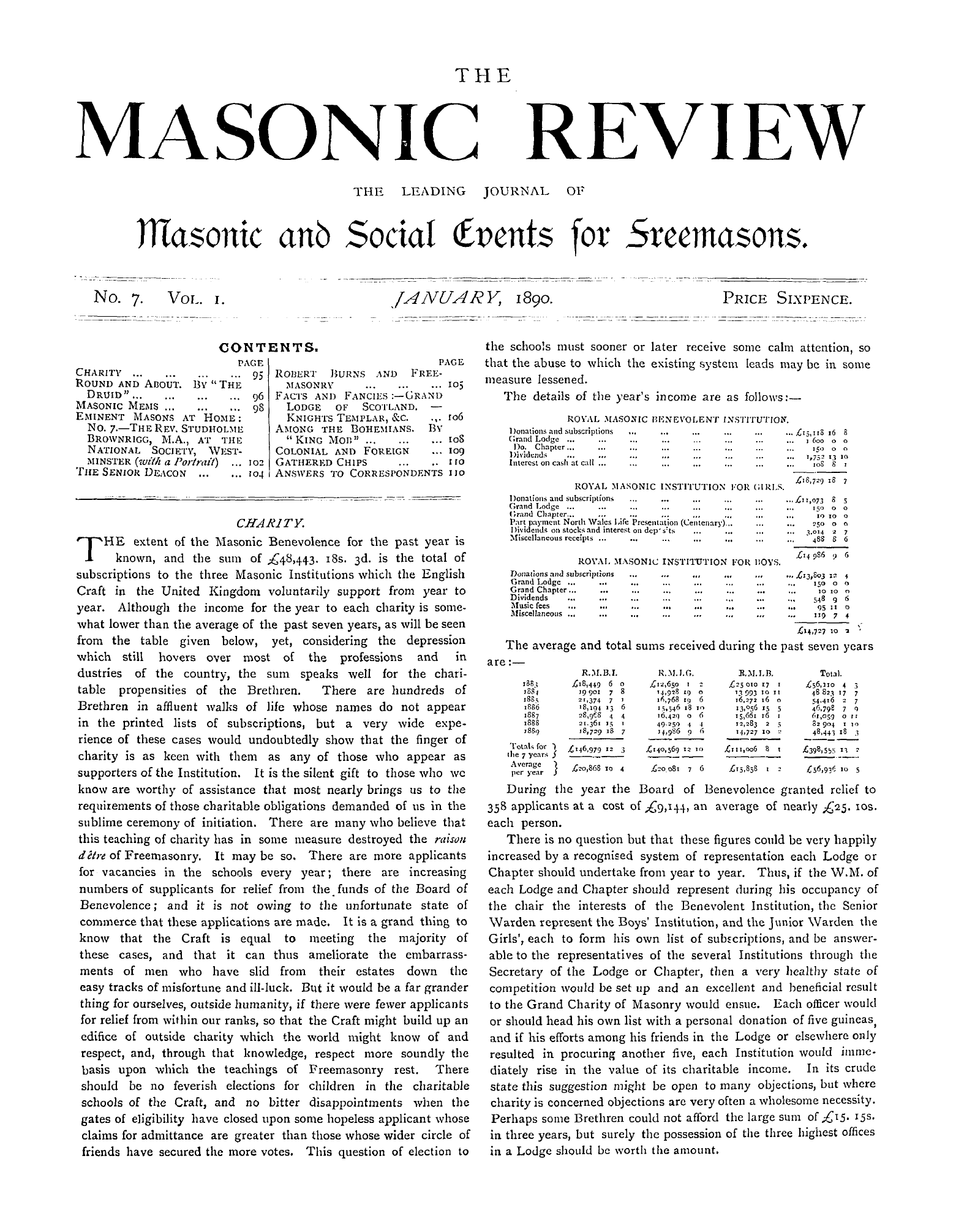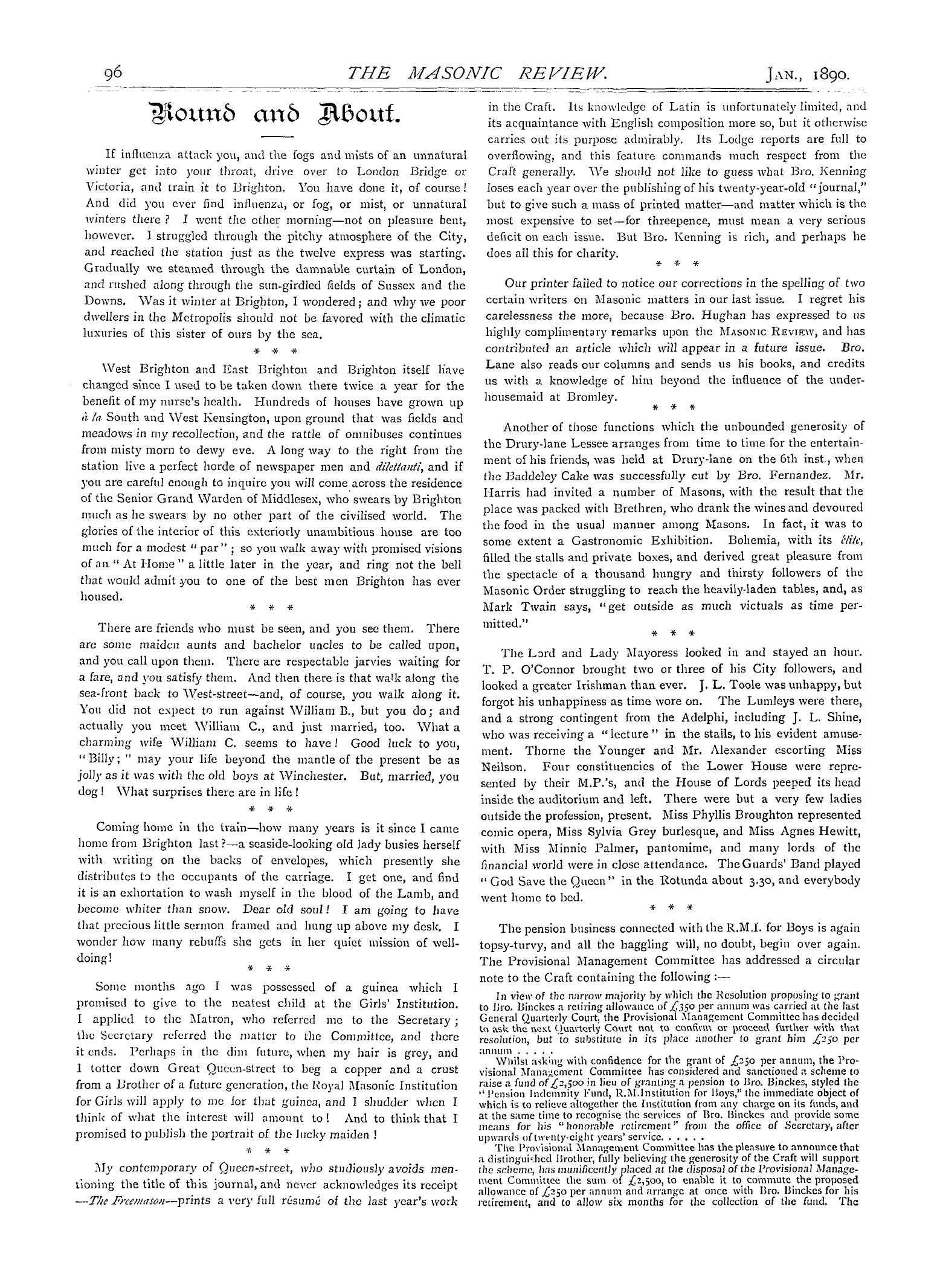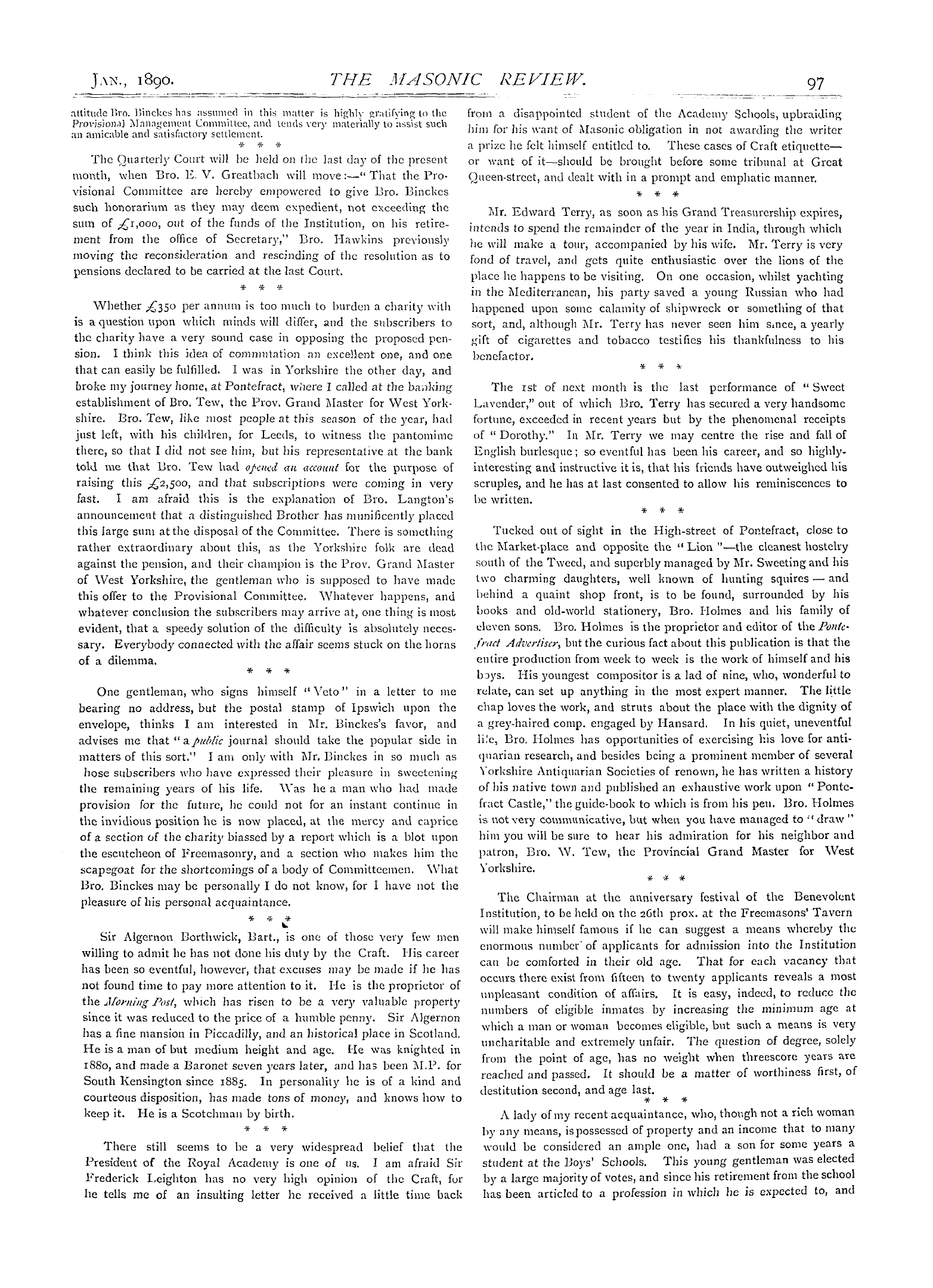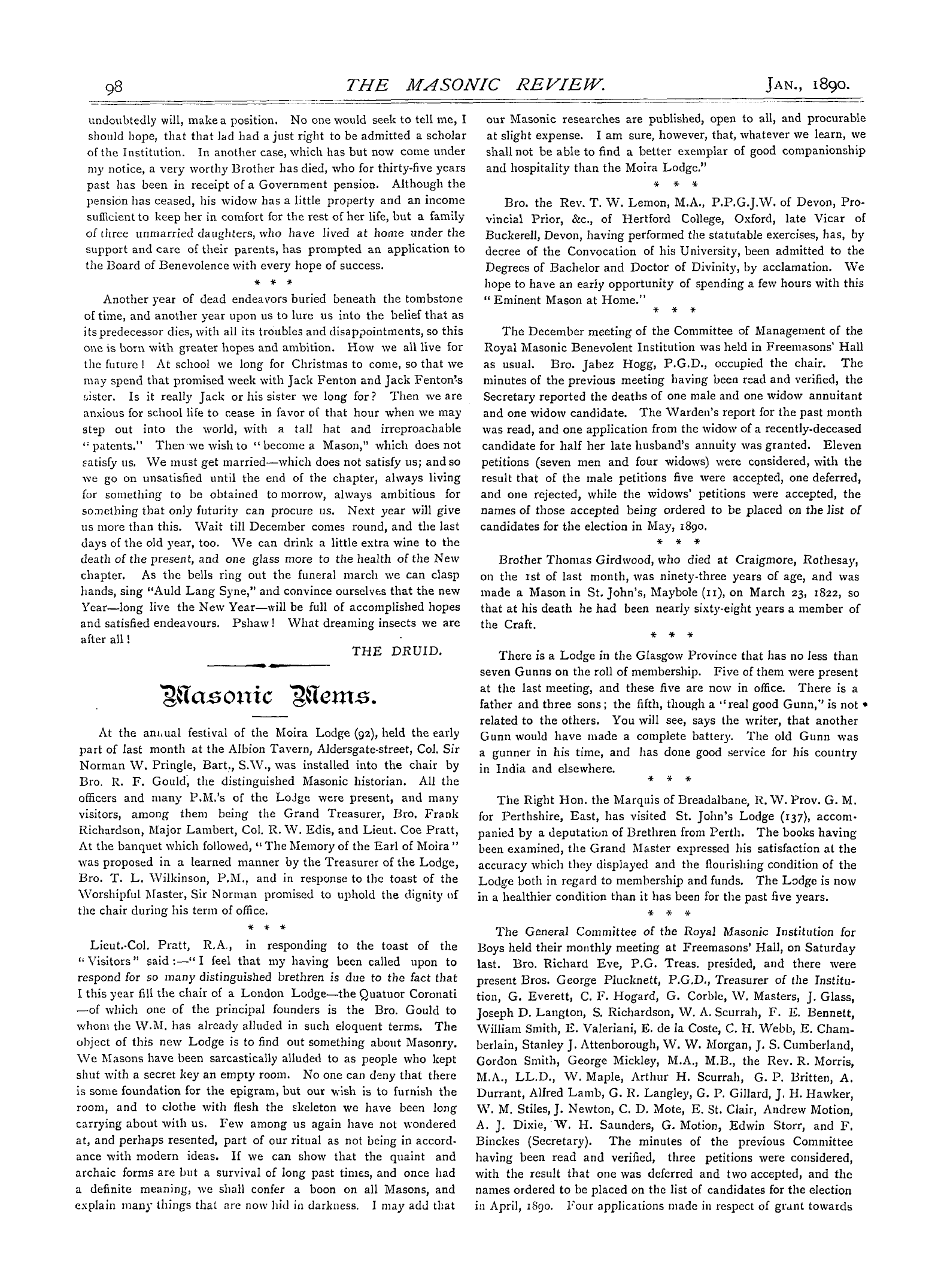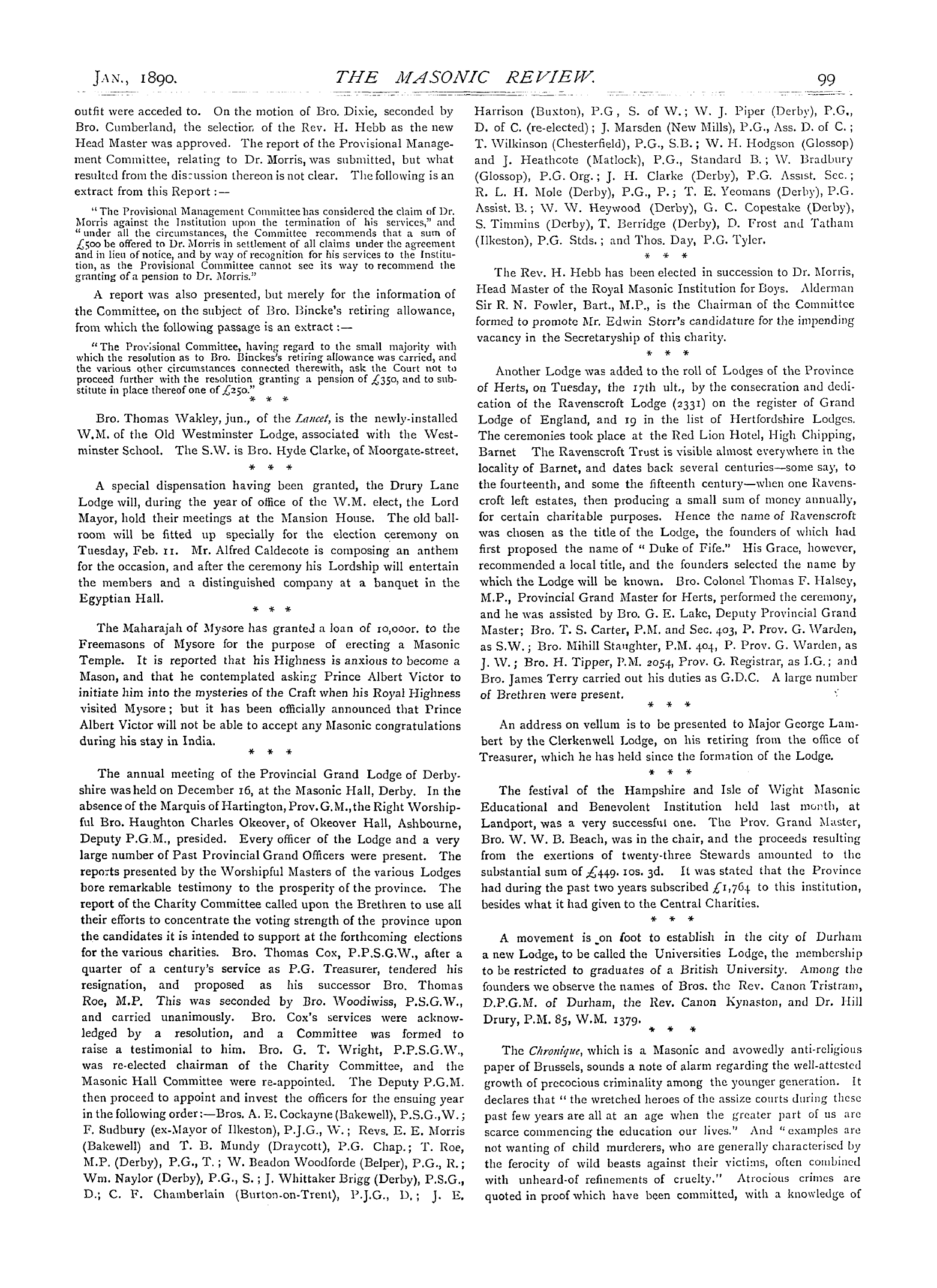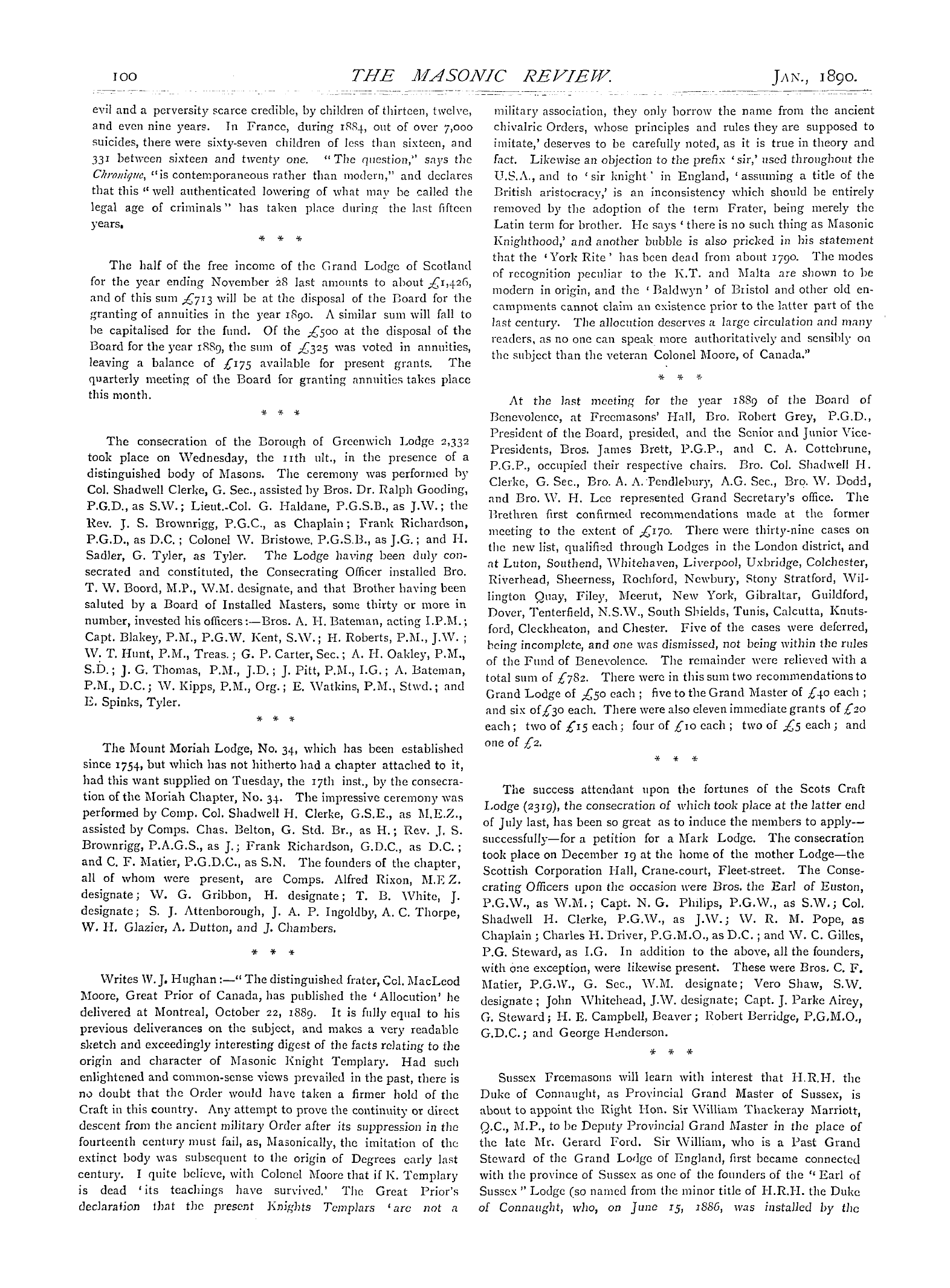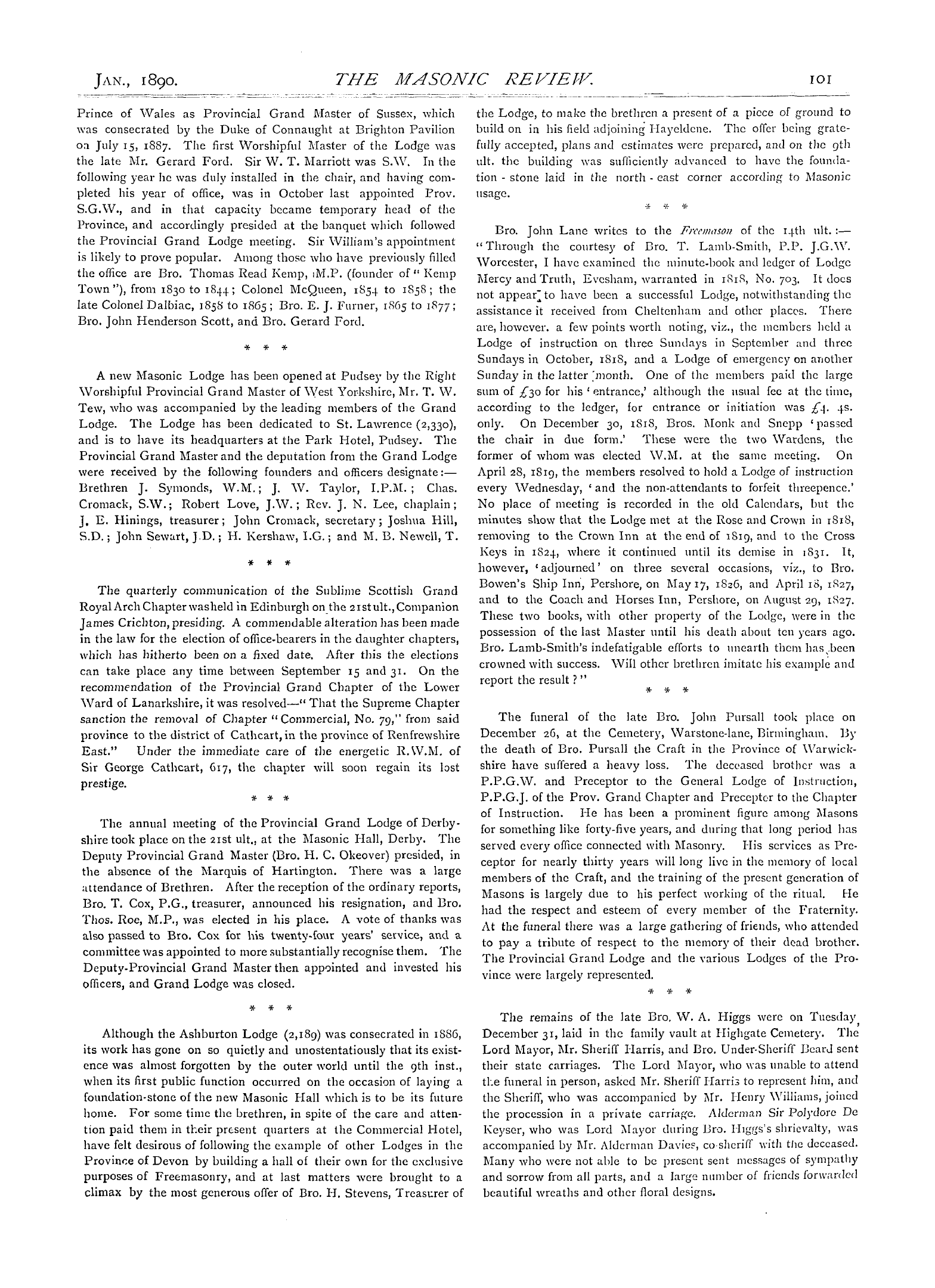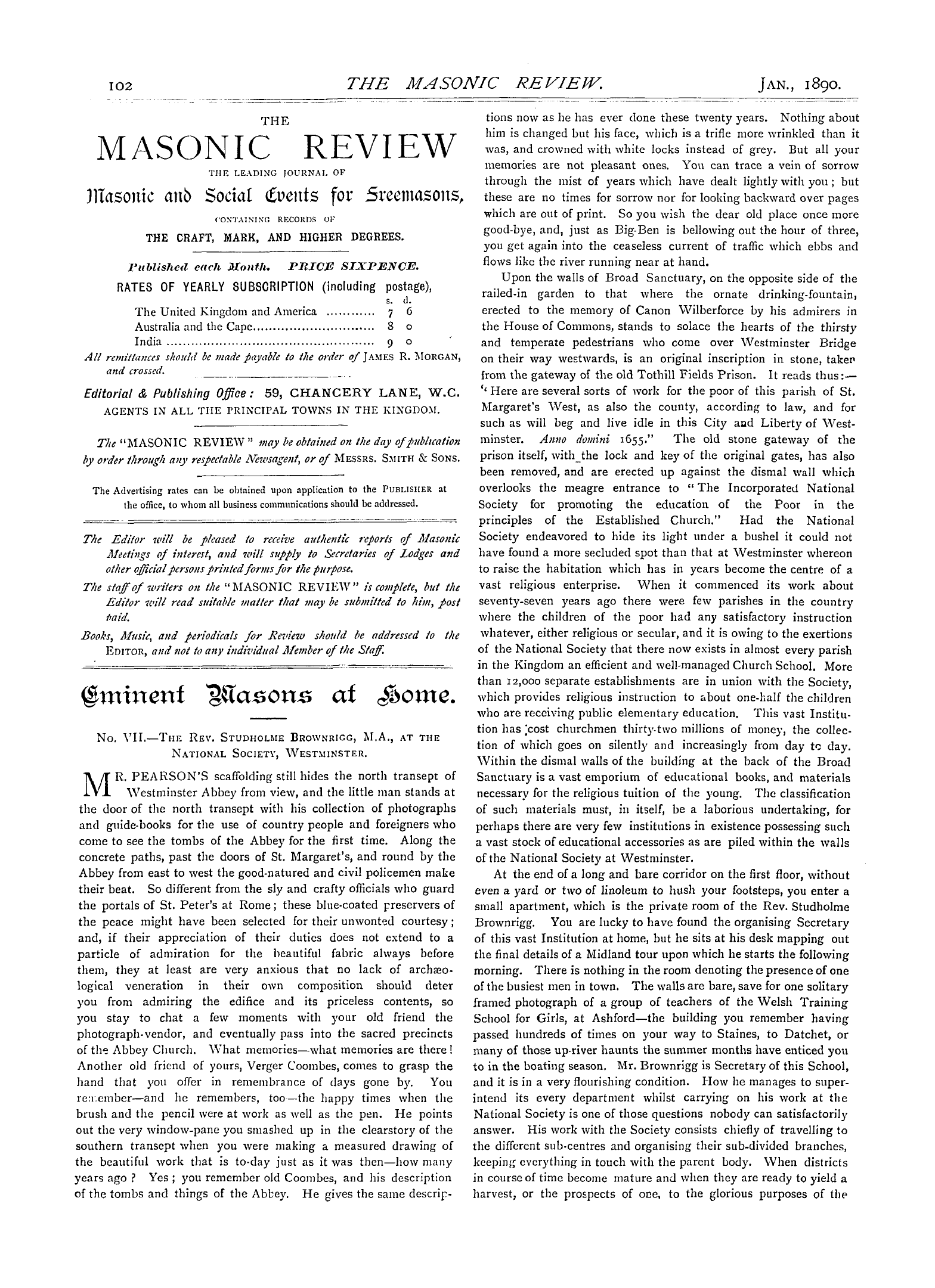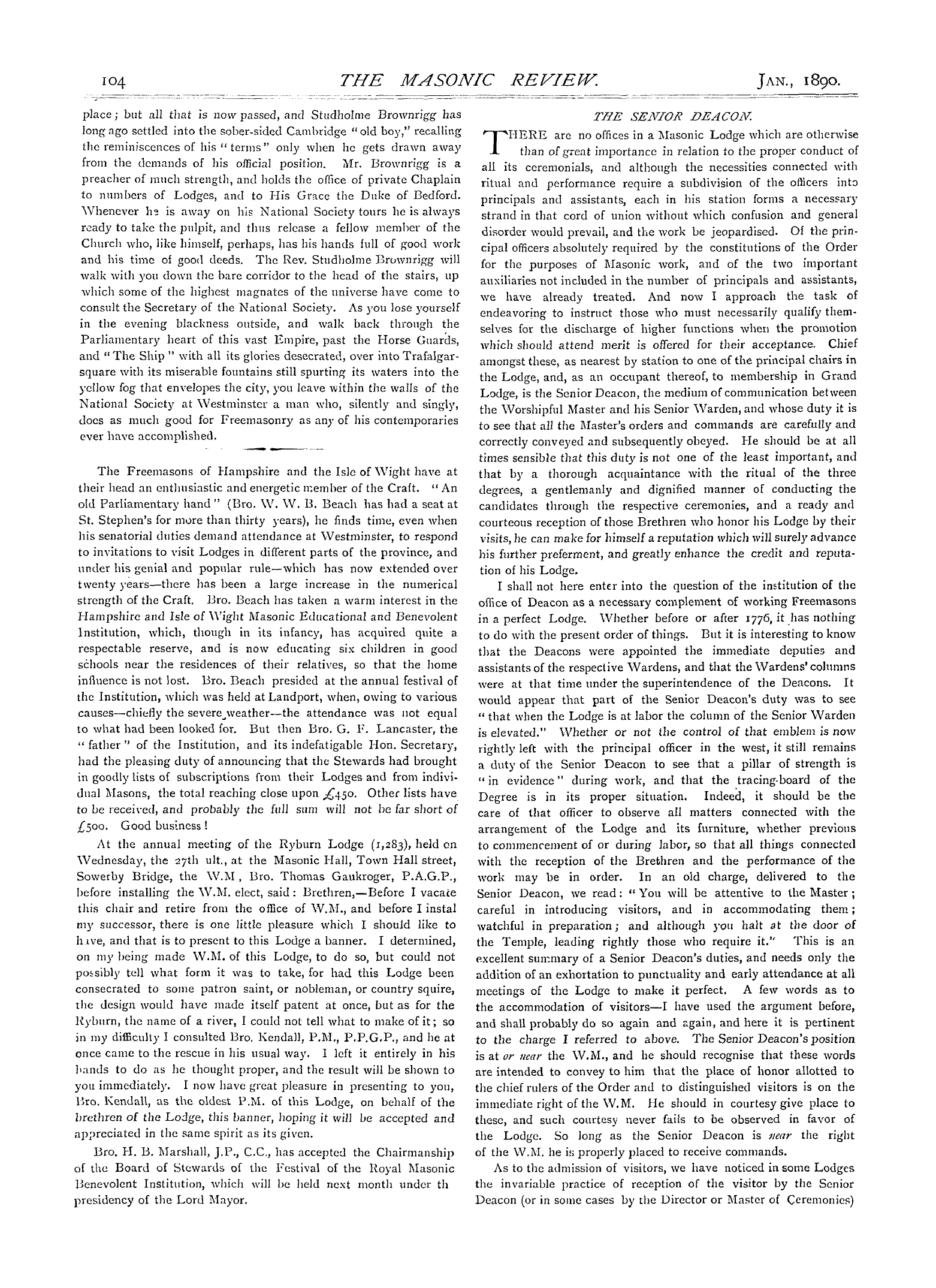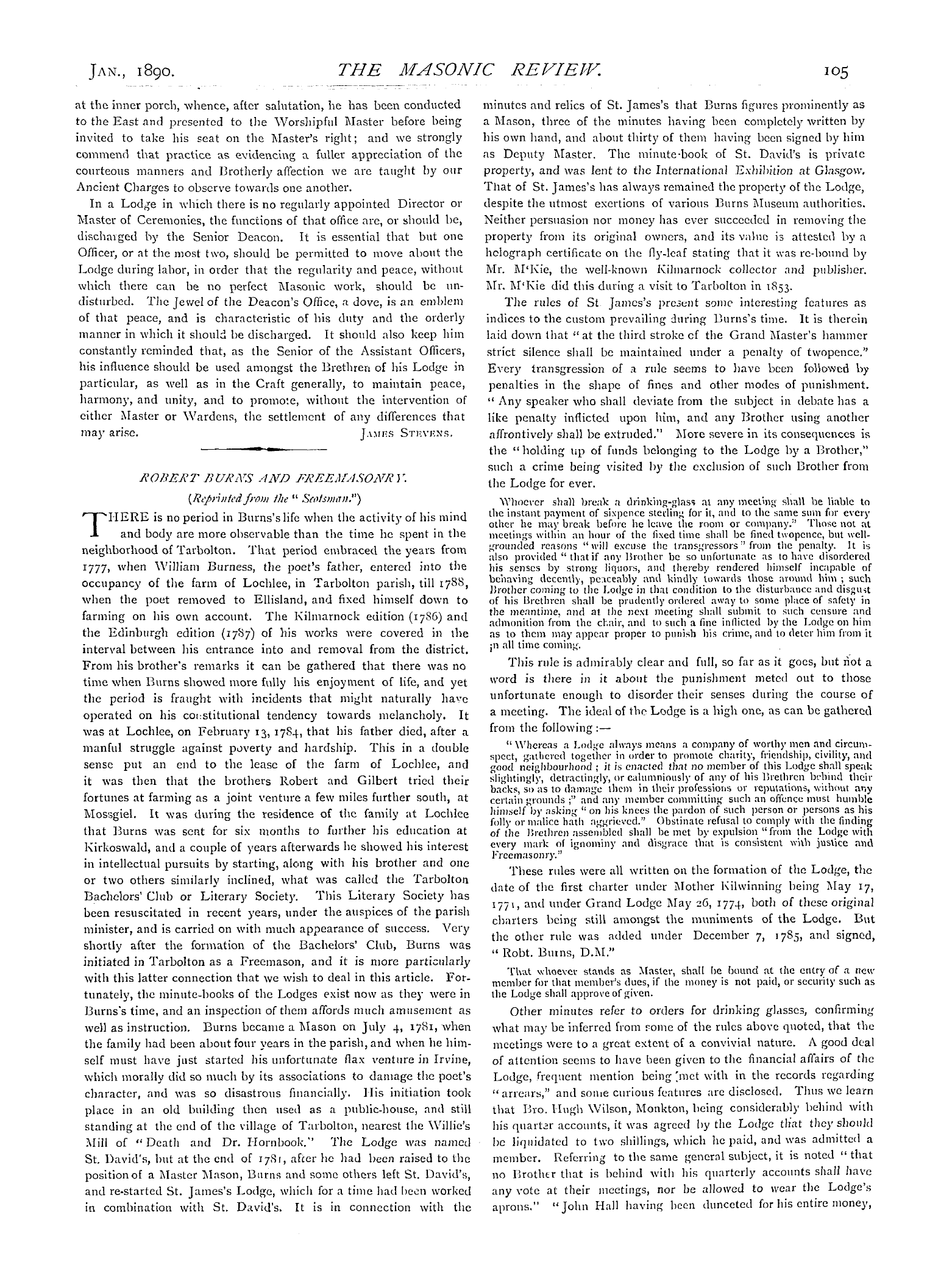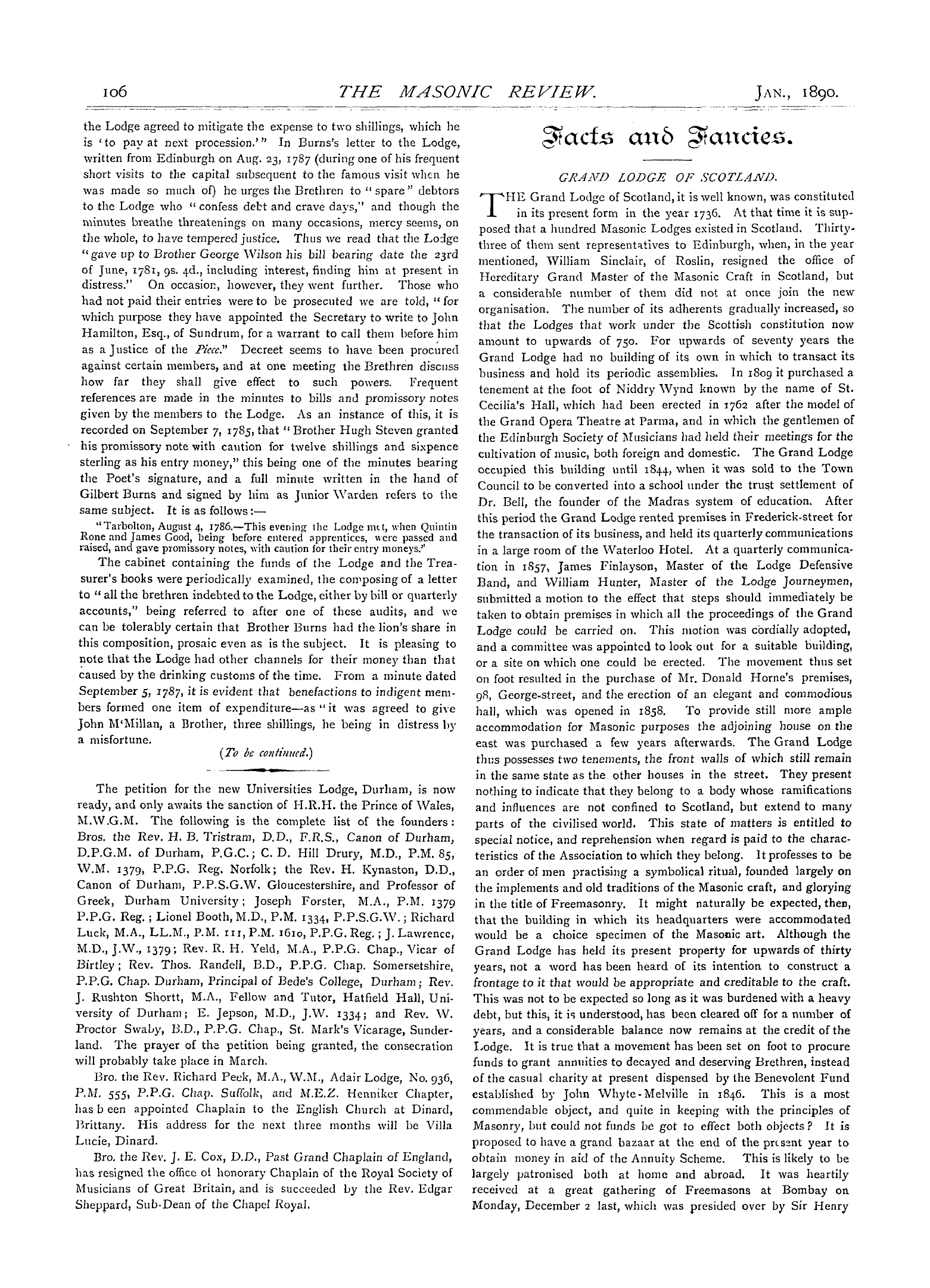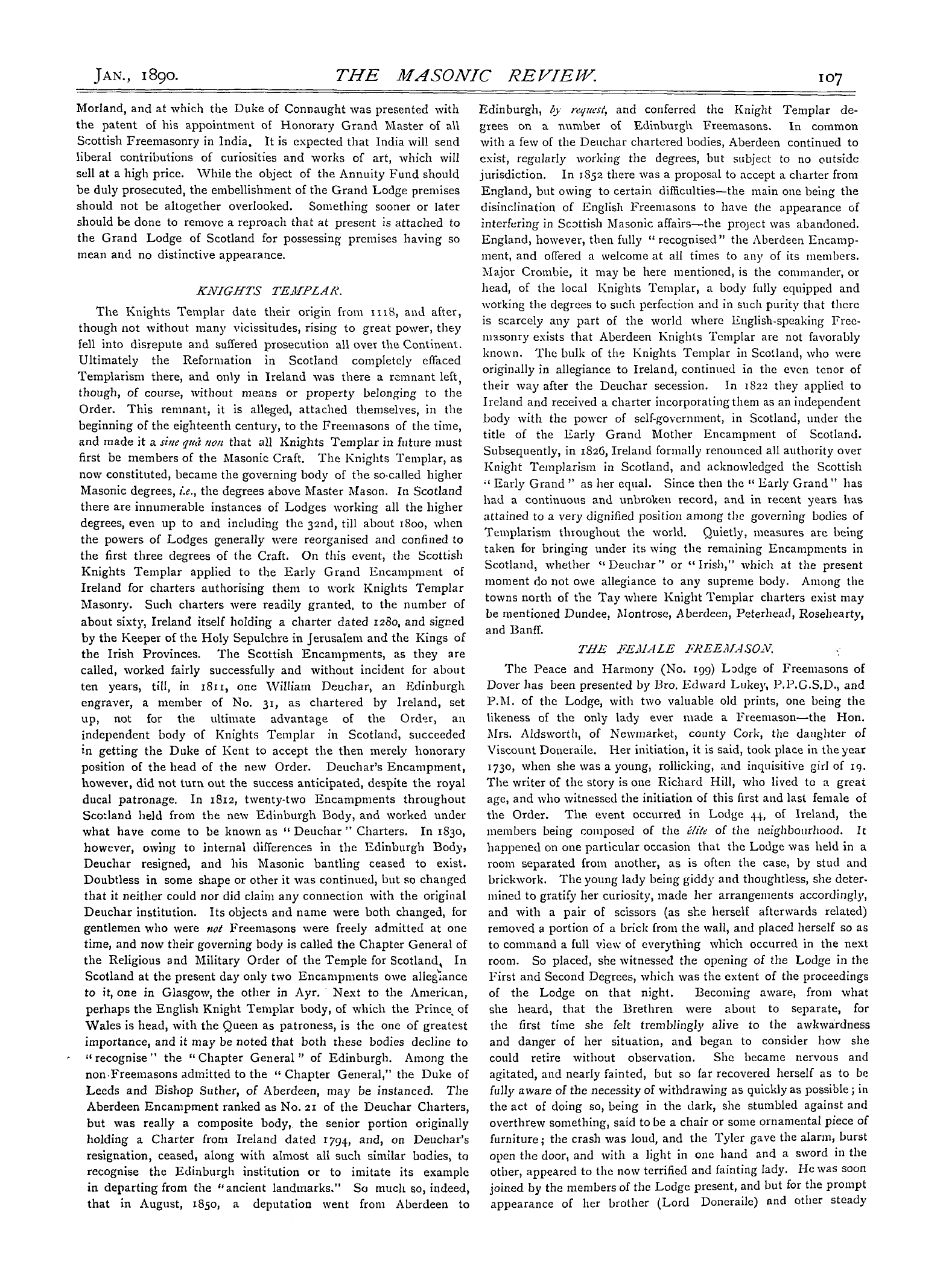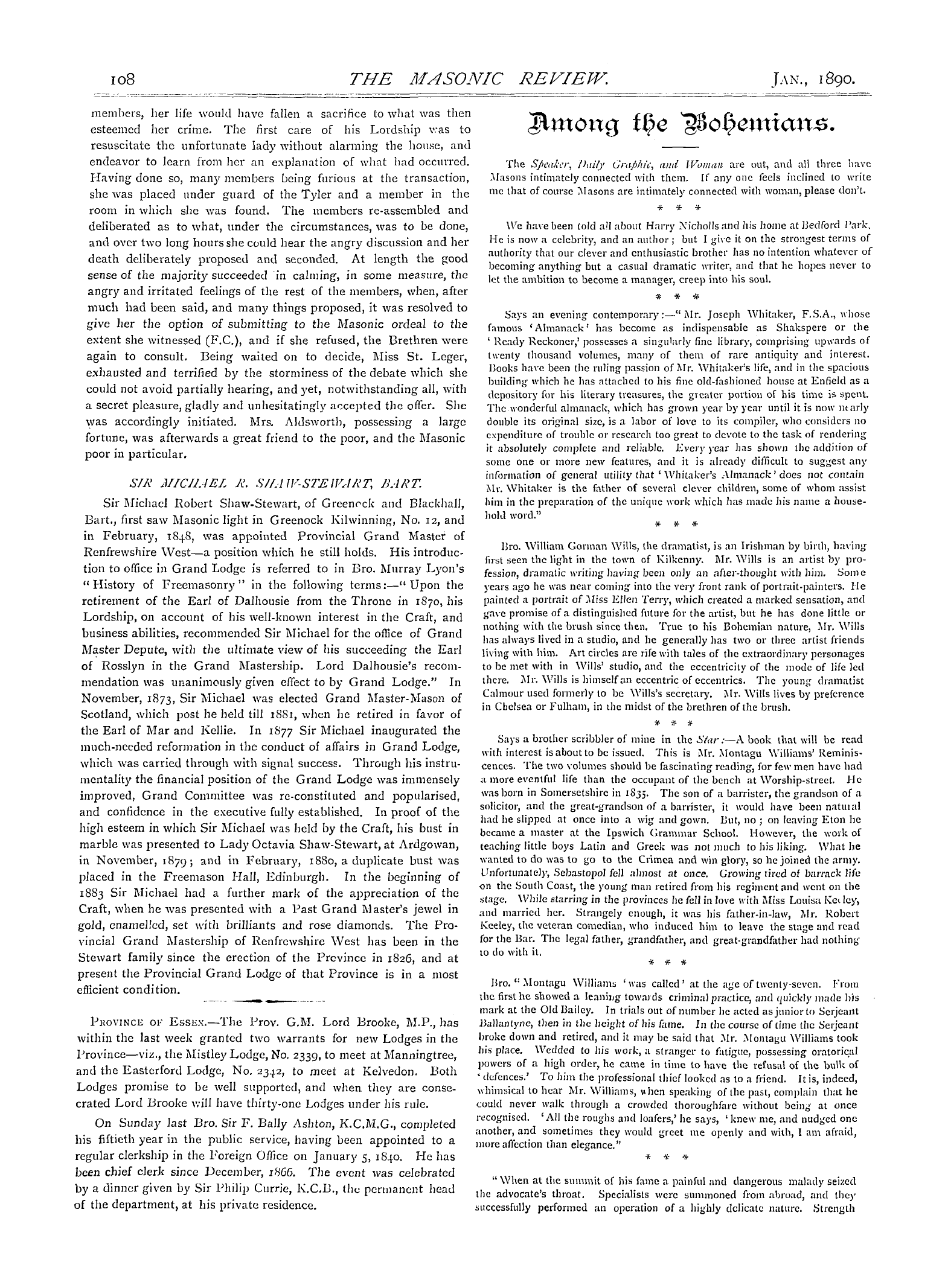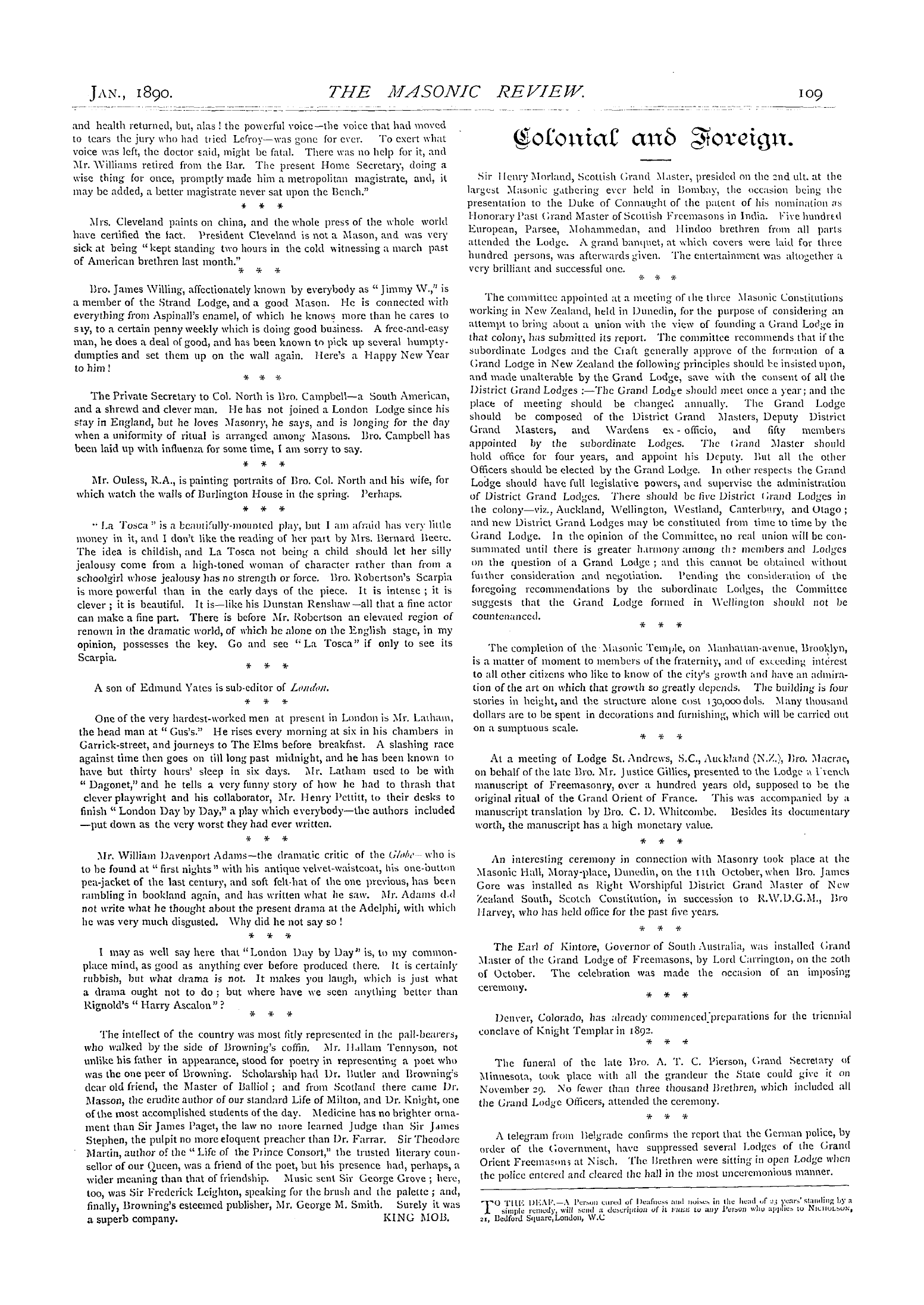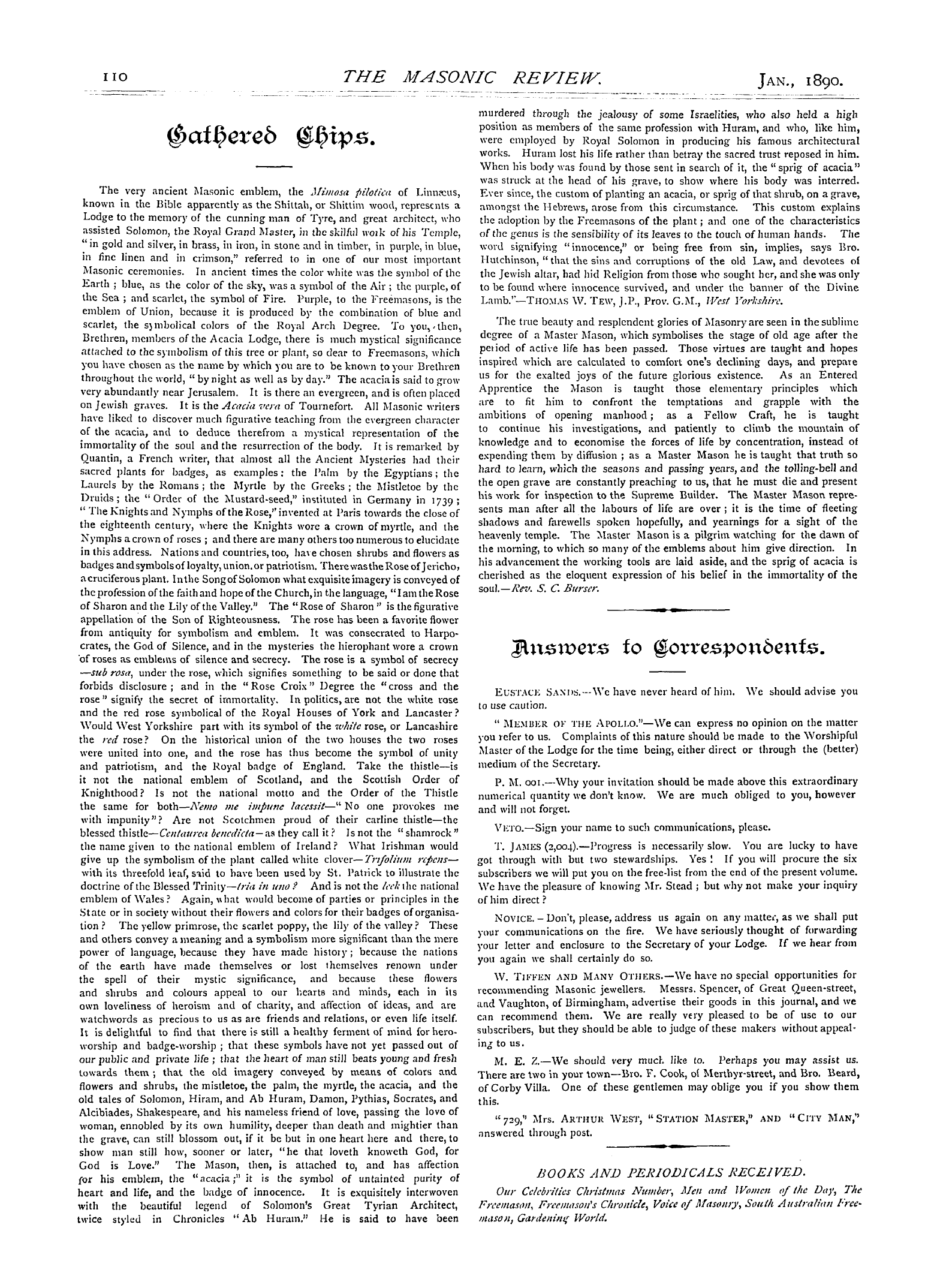-
Articles/Ads
Article Gathered Chips. Page 1 of 1 Article Gathered Chips. Page 1 of 1 Article Answers to Correspondents. Page 1 of 1 Article BOOKS AND PERIODICALS RECEIVED. Page 1 of 1
Note: This text has been automatically extracted via Optical Character Recognition (OCR) software.
Gathered Chips.
Gathered Chips .
The very ancient Masonic emblem , the Mimosa pilotica of Linnjcus , known in the Bible apparently as the Shittah , or Shittim wood , represents a Lodge to the memory of the cunning man of Tyre , and great architect , who assisted Solomon , the Royal Grand Master , in the skilful woik of his Temple , " in gold and silver , in brass , in iron , in stone and in timber , in purple , in blue , in fine linen and in crimson , " referred to in one of our most important
Masonic ceremonies . In ancient times the color white was the symbol of the Earth ; blue , as the color of the sky , was a symbol of the Air ; the purple , of the Sea ; and scarlet , the symbol of Fire . Purple , to the Freemasons , is the emblem of Union , because it is produced by the combination of blue and scarlet , the sjmbolical colors of the Royal Arch Degree . To you , . then , Brethren , members of the Acacia Lodge , there is much mystical significance
attached to the symbolism of this tree or plant , so clear to Freemasons , which you have chosen as the name by which you are to be known to your Brethren throughout the world , " by night as well as by day . " The acacia is said to grow very abundantly near Jerusalem . It is there an evergreen , and is often placed on Jewish graves . It is the Acacia vera of Tournefort . All Masonic writers have liked to discover much figurative teaching from the evergreen character
of the acacia , and to deduce therefrom a mystical representation of the immortality of the soul and the resurrection of the body . It is remarked by Quantin , a French writer , that almost all the Ancient Mysteries had their
sacred plants for badges , as examples : the Palm by the Egyptians ; the Laurels by the Romans ; the Myrtle by the Greeks ; the Mistletoe by the Druids ; the "Order of the Mustard-seed , " instituted in Germany in 1739 ; " The Knights and Nymphs of the Rose , " invented at Paris towards the close of the eighteenth century , where the Knights wore a crown of myrtle , and the Nymphs a crown of roses ; and there are many others too numerous to elucidate
in this address . Nations and countries , too , have chosen shrubs and flowers as badges andsymbolsof loyalty , union . or patriotism . There was the Rose of Jericho , acruciferous plant . Inthe Songof Solomon what exquisite imagery is conveyed of the profession of the faithandhopeof the Church , in the language , "I am the Rose of Sharon and the Lily of the Valley . " The "Rose of Sharon " is the figurative appellation of the Son of Righteousness . The rose has been a favorite flower
from antiquity for symbolism and emblem . It was consecrated to Harpocrates , the God of Silence , and in the mysteries the hierophant wore a crown of roses as emblems of silence and secrecy . The rose is a symbol of secrecy —sub rosa , under the rose , which signifies something to be said or done that forbids disclosure ; and in the " Rose Croix " Degree the " cross and the rose " signify the secret of immortality . In politics , are not the white rose and the red rose symbolical of the Royal Houses of York and Lancaster ? Would West Yorkshire part with its symbol of the white rose , or Lancashire the red rose ? On the historical union of the two houses the two roses
were united into one , and the rose has thus become the symbol of unity and patriotism , and the Royal badge of England . Take the thistle—is it not the national emblem of Scotland , and the Scottish Order of Knighthood ? Is not the national motto and the Order of the Thistle the same for both—Nemo me impunc laccssit— " No one provokes me with impunity" ? Are not Scotchmen proud of their carline thistle—the blessed thistle—Ccntatirca beuedicta—ast they call it ? Is not the "shamrock "
the name given to the national emblem of Ireland ? What Irishman would give up the symbolism of the plant called white clover—Tnfolium repenswith its threefold leaf , slid to have been used by St . Patrick to illustrate the doctrine of the Blessed Trinity—tria in una ? And is not the leek the national emblem of Wales ? Again , what would become of parties or principles in the State or in society without their flowers and colors for their badges of
organisation ? The yellow primrose , the scarlet poppy , the lily of the valley ? These and others convey a meaning and a symbolism more significant than the mere power of language , because they have made history ; because the nations of the earth have made themselves or lost themselves renown under the spell of their mystic significance , and because these flowers and shrubs and colours appeal to our hearts and minds , each in its
own loveliness of heroism and of charity , and affection of ideas , and are watchwords as precious to us as are friends and relations , or even life itself . It is delightful to find that there is still a healthy ferment of mind for heroworship and badge-worship ; that these symbols have not yet passed out of our public and private life ; that the heart of man still beats young and fresh towards them ; that the old imagery conveyed by means of colors and
flowers and shrubs , the mistletoe , the palm , the myrtle , the acacia , and the old tales of Solomon , Hiram , and Ab Huram , Damon , Pythias , Socrates , and Alcibiades , Shakespeare , and his nameless friend of love , passing the love of woman , ennobled by its own humility , deeper than death and mightier than the grave , can still blossom out , if it be but in one heart here and there , to show man still how , sooner or later , "he that loveth knoweth God , for
God is Love . " The Mason , then , is attached to , and has affection for his emblem , the "acacia ; " it is the symbol of untainted purity of heart and life , and the badge of innocence . It is exquisitely interwoven with the beautiful legend of Solomon ' s Great Tyrian Architect , twice styled in Chronicles " Ab Huram . " He is said to have been
Gathered Chips.
murdered through the jealousy of some Israelites , who also held a high position as members of the same profession with Huram , and who , like him , were employed by Royal Solomon in producing his famous architectural works . Huram lost his life rather than betray the sacred trust reposed in him . When his body was found by those sent in search of it , the " sprig of acacia " was struck at the head of his grave , to show where his body was interred .
Ever since , the custom of planting an acacia , or sprig of that shrub , on a grave , amongst the Hebrews , arose from this circumstance . This custom explains the adoption by the Freemasons of the plant ; and one of the characteristics of the genus is the sensibility of its leaves to the touch of human hands . The word signifying "innocence , " or being free from sin , implies , says Bro . Hutchinson , " that the sins and corruptions of the old Law , and devotees of the Jewish altar , had hid Religion from those who sought her , and she was only to be found where innocence survived , and under the banner of the Divine Lamb . ' '—THOMAS W . TEW , J . P ., Prov . G . M ., West Yorkshire .
The true beauty and resplendent glories of Masonry are seen in the sublime degree of a Master Mason , which symbolises the stage of old age after the peiiod of active life has been passed . Those virtues are taught and hopes inspired which are calculated to comfort one ' s declining days , and prepare us for the exalted joys of the future glorious existence . As an Entered Apprentice the Mason is taught those elementary principles which
are to fit him to confront the temptations and grapple with the ambitions of opening manhood ; as a Fellow Craft , he is taught to continue his investigations , and patiently to climb the mountain of knowledge and to economise the forces of life by concentration , instead of expending them by diffusion ; as a Master Mason he is taught that truth so hard to learn , which the seasons and passing years , and the tolling-bell and
the open grave are constantly preaching to us , that he must die and present his work for inspection to the Supreme Builder . The Master Mason represents man after all the labours of life are over ; it is the time of fleeting shadows and farewells spoken hopefully , and yearnings for a sight of the heavenly temple . The Master Mason is a pilgrim watching for the dawn of the morning , to which so many of the emblems about him give direction . In his advancement the working tools are laid aside , and the sprig of acacia is cherished as the eloquent expression of his belief in the immortality of the soul . —Rev . S . C . Bursa :
Answers To Correspondents.
Answers to Correspondents .
EUSTACE SANDS . —We have never heard of him . We should advise you to use caution . " MEMBER OK THE APOLLO . " —We can express no opinion on the matter you refer to us . Complaints of this nature should be made to the Worshipful Master of the Lodge for the time being , either direct or through the ( better ) medium of the Secretary .
P . M . 001 . —Why your invitation should be made above this extraordinary numerical quantity we don't know . We are much obliged to you , however and will not forget . VETO . —Sign your name to such communications , please . T . J AMES ( 2 , 004 ) . —Progress is necessarily slow . You are lucky to have
got through with but two stewardships . Yes ! If you will procure the six subscribers we will put you on the free-list from the end of the present volume . We have the pleasure of knowing Mr . Stead ; but why not make your inquiry of him direct ? NOVICE . - Don ' t , please , address us again on any matter , as we shall put your communications on the fire . We have seriously thought of forwarding
your letter and enclosure to the Secretary of your Lodge . If we hear from you again we shall certainly do so . W . TIFKEN AND MANY OTHERS . —We have no special opportunities for recommending Masonic jewellers . Messrs . Spencer , of Great Queen-street , and Vaughton , of Birmingham , advertise their goods in this journal , and we can recommend them . We are really very pleased to be of use to our
subscribers , but they should be able to judge of these makers without appealing to us . M . E . Z . —We should very much like to . Perhaps you may assist us . There are two in your town—Bro . F . Cook , of Merthyr-street , and Bro . Beard , of Corby Villa . One of these gentlemen may oblige you if you show them this . " 729 , " Mrs . A RTHUR WEST , "STATION MASTER , " "CITY MAN , " answered through post .
Books And Periodicals Received.
BOOKS AND PERIODICALS RECEIVED .
Our Celebrilies Christmas Number , Men and Women of the Day , The Freemason , Freemason ' s Chronicle , Voice of Masonry , South Australian Freemason , Gardening World .
Note: This text has been automatically extracted via Optical Character Recognition (OCR) software.
Gathered Chips.
Gathered Chips .
The very ancient Masonic emblem , the Mimosa pilotica of Linnjcus , known in the Bible apparently as the Shittah , or Shittim wood , represents a Lodge to the memory of the cunning man of Tyre , and great architect , who assisted Solomon , the Royal Grand Master , in the skilful woik of his Temple , " in gold and silver , in brass , in iron , in stone and in timber , in purple , in blue , in fine linen and in crimson , " referred to in one of our most important
Masonic ceremonies . In ancient times the color white was the symbol of the Earth ; blue , as the color of the sky , was a symbol of the Air ; the purple , of the Sea ; and scarlet , the symbol of Fire . Purple , to the Freemasons , is the emblem of Union , because it is produced by the combination of blue and scarlet , the sjmbolical colors of the Royal Arch Degree . To you , . then , Brethren , members of the Acacia Lodge , there is much mystical significance
attached to the symbolism of this tree or plant , so clear to Freemasons , which you have chosen as the name by which you are to be known to your Brethren throughout the world , " by night as well as by day . " The acacia is said to grow very abundantly near Jerusalem . It is there an evergreen , and is often placed on Jewish graves . It is the Acacia vera of Tournefort . All Masonic writers have liked to discover much figurative teaching from the evergreen character
of the acacia , and to deduce therefrom a mystical representation of the immortality of the soul and the resurrection of the body . It is remarked by Quantin , a French writer , that almost all the Ancient Mysteries had their
sacred plants for badges , as examples : the Palm by the Egyptians ; the Laurels by the Romans ; the Myrtle by the Greeks ; the Mistletoe by the Druids ; the "Order of the Mustard-seed , " instituted in Germany in 1739 ; " The Knights and Nymphs of the Rose , " invented at Paris towards the close of the eighteenth century , where the Knights wore a crown of myrtle , and the Nymphs a crown of roses ; and there are many others too numerous to elucidate
in this address . Nations and countries , too , have chosen shrubs and flowers as badges andsymbolsof loyalty , union . or patriotism . There was the Rose of Jericho , acruciferous plant . Inthe Songof Solomon what exquisite imagery is conveyed of the profession of the faithandhopeof the Church , in the language , "I am the Rose of Sharon and the Lily of the Valley . " The "Rose of Sharon " is the figurative appellation of the Son of Righteousness . The rose has been a favorite flower
from antiquity for symbolism and emblem . It was consecrated to Harpocrates , the God of Silence , and in the mysteries the hierophant wore a crown of roses as emblems of silence and secrecy . The rose is a symbol of secrecy —sub rosa , under the rose , which signifies something to be said or done that forbids disclosure ; and in the " Rose Croix " Degree the " cross and the rose " signify the secret of immortality . In politics , are not the white rose and the red rose symbolical of the Royal Houses of York and Lancaster ? Would West Yorkshire part with its symbol of the white rose , or Lancashire the red rose ? On the historical union of the two houses the two roses
were united into one , and the rose has thus become the symbol of unity and patriotism , and the Royal badge of England . Take the thistle—is it not the national emblem of Scotland , and the Scottish Order of Knighthood ? Is not the national motto and the Order of the Thistle the same for both—Nemo me impunc laccssit— " No one provokes me with impunity" ? Are not Scotchmen proud of their carline thistle—the blessed thistle—Ccntatirca beuedicta—ast they call it ? Is not the "shamrock "
the name given to the national emblem of Ireland ? What Irishman would give up the symbolism of the plant called white clover—Tnfolium repenswith its threefold leaf , slid to have been used by St . Patrick to illustrate the doctrine of the Blessed Trinity—tria in una ? And is not the leek the national emblem of Wales ? Again , what would become of parties or principles in the State or in society without their flowers and colors for their badges of
organisation ? The yellow primrose , the scarlet poppy , the lily of the valley ? These and others convey a meaning and a symbolism more significant than the mere power of language , because they have made history ; because the nations of the earth have made themselves or lost themselves renown under the spell of their mystic significance , and because these flowers and shrubs and colours appeal to our hearts and minds , each in its
own loveliness of heroism and of charity , and affection of ideas , and are watchwords as precious to us as are friends and relations , or even life itself . It is delightful to find that there is still a healthy ferment of mind for heroworship and badge-worship ; that these symbols have not yet passed out of our public and private life ; that the heart of man still beats young and fresh towards them ; that the old imagery conveyed by means of colors and
flowers and shrubs , the mistletoe , the palm , the myrtle , the acacia , and the old tales of Solomon , Hiram , and Ab Huram , Damon , Pythias , Socrates , and Alcibiades , Shakespeare , and his nameless friend of love , passing the love of woman , ennobled by its own humility , deeper than death and mightier than the grave , can still blossom out , if it be but in one heart here and there , to show man still how , sooner or later , "he that loveth knoweth God , for
God is Love . " The Mason , then , is attached to , and has affection for his emblem , the "acacia ; " it is the symbol of untainted purity of heart and life , and the badge of innocence . It is exquisitely interwoven with the beautiful legend of Solomon ' s Great Tyrian Architect , twice styled in Chronicles " Ab Huram . " He is said to have been
Gathered Chips.
murdered through the jealousy of some Israelites , who also held a high position as members of the same profession with Huram , and who , like him , were employed by Royal Solomon in producing his famous architectural works . Huram lost his life rather than betray the sacred trust reposed in him . When his body was found by those sent in search of it , the " sprig of acacia " was struck at the head of his grave , to show where his body was interred .
Ever since , the custom of planting an acacia , or sprig of that shrub , on a grave , amongst the Hebrews , arose from this circumstance . This custom explains the adoption by the Freemasons of the plant ; and one of the characteristics of the genus is the sensibility of its leaves to the touch of human hands . The word signifying "innocence , " or being free from sin , implies , says Bro . Hutchinson , " that the sins and corruptions of the old Law , and devotees of the Jewish altar , had hid Religion from those who sought her , and she was only to be found where innocence survived , and under the banner of the Divine Lamb . ' '—THOMAS W . TEW , J . P ., Prov . G . M ., West Yorkshire .
The true beauty and resplendent glories of Masonry are seen in the sublime degree of a Master Mason , which symbolises the stage of old age after the peiiod of active life has been passed . Those virtues are taught and hopes inspired which are calculated to comfort one ' s declining days , and prepare us for the exalted joys of the future glorious existence . As an Entered Apprentice the Mason is taught those elementary principles which
are to fit him to confront the temptations and grapple with the ambitions of opening manhood ; as a Fellow Craft , he is taught to continue his investigations , and patiently to climb the mountain of knowledge and to economise the forces of life by concentration , instead of expending them by diffusion ; as a Master Mason he is taught that truth so hard to learn , which the seasons and passing years , and the tolling-bell and
the open grave are constantly preaching to us , that he must die and present his work for inspection to the Supreme Builder . The Master Mason represents man after all the labours of life are over ; it is the time of fleeting shadows and farewells spoken hopefully , and yearnings for a sight of the heavenly temple . The Master Mason is a pilgrim watching for the dawn of the morning , to which so many of the emblems about him give direction . In his advancement the working tools are laid aside , and the sprig of acacia is cherished as the eloquent expression of his belief in the immortality of the soul . —Rev . S . C . Bursa :
Answers To Correspondents.
Answers to Correspondents .
EUSTACE SANDS . —We have never heard of him . We should advise you to use caution . " MEMBER OK THE APOLLO . " —We can express no opinion on the matter you refer to us . Complaints of this nature should be made to the Worshipful Master of the Lodge for the time being , either direct or through the ( better ) medium of the Secretary .
P . M . 001 . —Why your invitation should be made above this extraordinary numerical quantity we don't know . We are much obliged to you , however and will not forget . VETO . —Sign your name to such communications , please . T . J AMES ( 2 , 004 ) . —Progress is necessarily slow . You are lucky to have
got through with but two stewardships . Yes ! If you will procure the six subscribers we will put you on the free-list from the end of the present volume . We have the pleasure of knowing Mr . Stead ; but why not make your inquiry of him direct ? NOVICE . - Don ' t , please , address us again on any matter , as we shall put your communications on the fire . We have seriously thought of forwarding
your letter and enclosure to the Secretary of your Lodge . If we hear from you again we shall certainly do so . W . TIFKEN AND MANY OTHERS . —We have no special opportunities for recommending Masonic jewellers . Messrs . Spencer , of Great Queen-street , and Vaughton , of Birmingham , advertise their goods in this journal , and we can recommend them . We are really very pleased to be of use to our
subscribers , but they should be able to judge of these makers without appealing to us . M . E . Z . —We should very much like to . Perhaps you may assist us . There are two in your town—Bro . F . Cook , of Merthyr-street , and Bro . Beard , of Corby Villa . One of these gentlemen may oblige you if you show them this . " 729 , " Mrs . A RTHUR WEST , "STATION MASTER , " "CITY MAN , " answered through post .
Books And Periodicals Received.
BOOKS AND PERIODICALS RECEIVED .
Our Celebrilies Christmas Number , Men and Women of the Day , The Freemason , Freemason ' s Chronicle , Voice of Masonry , South Australian Freemason , Gardening World .
